March 19, 2021
Air Date: March 19, 2021
FULL SHOW
SEGMENTS
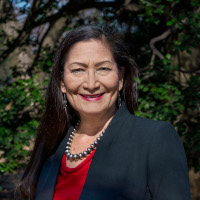
Madam Secretary Haaland
View the page for this story
On March 15th the U.S. Senate voted 51-40 to confirm Deb Haaland as Secretary of the Interior. A member of the Laguna Pueblo tribe, Secretary Haaland is the first Native American to serve as head of a cabinet agency. Her historic appointment places her in command of a department that manages US public lands and oversees the Bureaus of Indian Affairs and India Education. Host Bobby Bascomb discusses Ms. Haaland’s appointment and her priorities for the future of the department. (02:19)

One in Five Deaths from Fossil Fuels
View the page for this story
Ultrafine particulate matter emitted from fossil fuel combustion is known to cause numerous health issues, and a recent study finds that this pollution is responsible for one in five early deaths worldwide, including more than 300,000 deaths a year in the United States. Pediatrician Aaron Bernstein, who is the interim director of the Center for Climate, Health and the Global Environment at Harvard, joins Host Steve Curwood to discuss the implications of the research. (09:44)
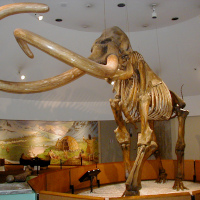
Note on Emerging Science: Oldest DNA Ever Sequenced
/ Grace CallahanView the page for this story
An international team of scientists has set a new record for the oldest DNA ever sequenced. This DNA, extracted from a mammoth tooth over a million years old, holds surprising clues to the evolutionary history of mammoths and represents an exciting technological breakthrough in the field of paleogenetics. Living on Earth’s Grace Callahan reports. (02:26)
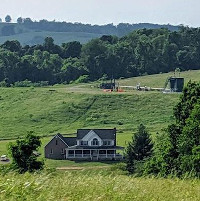
Families Sickened by Fracking
View the page for this story
The fracking boom transformed large swaths of rural America, turning towns from idyllic to industrial, and threatening the physical and mental health of many inhabitants. In a four-part series for Environmental Health News, Kristina Marusic tested five different families for 40 different chemicals associated with fracking and found that every person studied was carrying a massive chemical body burden. She joins Host Bobby Bascomb to talk about the families whose lives have been upended by their local fracking operations. (17:13)

Beyond the Headlines
/ Peter DykstraView the page for this story
In this week's Beyond the Headlines segment, Environmental Health News Editor Peter Dykstra and Host Steve Curwood talk about Philadelphia joining the Audubon's Lights Out Initiative meant to prevent migrating birds from dying in lit building collisions. Next, they highlight the much-awaited emergence of the Brood X cicadas, which happens every 17 years across a dozen states. Finally, they travel back in time to March 22, 1989 and the signing of the Basel Convention, which limited transboundary shipment of toxic waste and trash. (04:12)
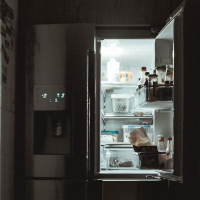
Carbon Bomb Fridges
View the page for this story
When climate reporter Phil McKenna needed a new fridge, he tried to steer clear of any appliance that would use super-potent greenhouse gases to cool his groceries. Despite his efforts he ended up with a “carbon bomb” containing a greenhouse gas thousands of times more potent than CO2. He wrote about his saga for Inside Climate News and joins Host Steve Curwood to talk about why industry has made it so hard to find climate-friendly appliances. (10:21)
Show Credits and Funders
Show Transcript
210319 Transcript
HOSTS: Bobby Bascomb, Steve Curwood
GUESTS: Aaron Bernstein, Kristina Marusic, Phil McKenna
REPORTERS: Grace Callahan, Peter Dykstra
[THEME]
CURWOOD: From PRX – this is Living On Earth.
[THEME]
CURWOOD: I’m Steve Curwood
BASCOMB: And I’m Bobby Bascomb
The US senate confirms Deb Haaland as the first Native American to serve as Secretary of the Department of Interior.
HAALAND: This historic nature of my confirmation is not lost on me, but I will say, it’s not about me. Rather, I hope this nomination would be an inspiration for Americans moving forward together as one nation and creating opportunities for all of us.
CURWOOD: Also, researchers find 300,000 American die prematurely every year, thanks to tiny particle pollution from fossil fuels.
BERNSTEIN: Globally they estimate that somewhere around 8+ million people are dying every year from air pollution that comes from burning fossil fuels, which is roughly 1 in 5 deaths worldwide, which is just stunning.
CURWOOD: That and more this week on Living on Earth – Stick Around!
[NEWSBREAK MUSIC: Boards Of Canada “Zoetrope” from “In A Beautiful Place Out In The Country” (Warp Records 2000)]
[THEME]
Madam Secretary Haaland
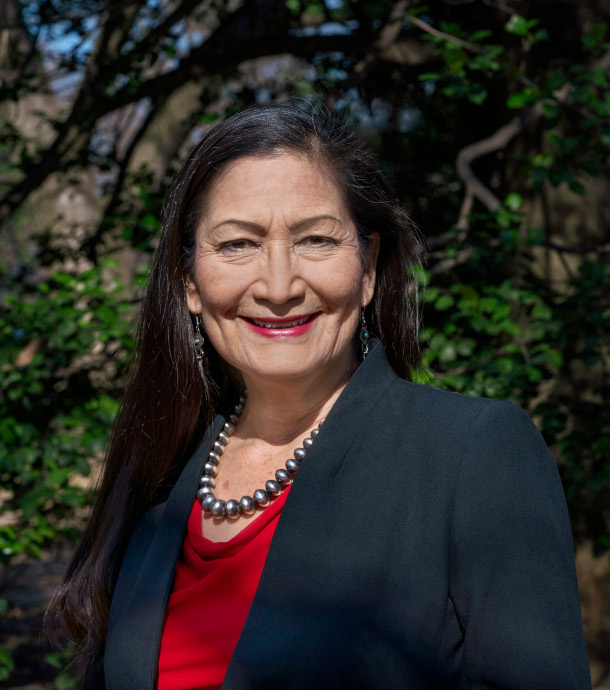
Deb Haaland was confirmed as Secretary of the Interior on March 15, 2021, making her the first Native American to serve as a cabinet secretary. Ms. Haaland previously served as a Democratic representative for New Mexico’s 1st congressional district from 2019 to 2021. (Photo: United States Department of the Interior)
CURWOOD: From PRX and the Jennifer and Ted Stanley Studios at the University of Massachusetts Boston, this is Living on Earth. I’m Steve Curwood.
BASCOMB: And I’m Bobby Bascomb
Deb Haaland is now the first Native American to serve as Secretary of the US Department of Interior after her confirmation squeaked through with just 51 votes in the US Senate. No stranger to being first, she was also one of the two first Native Americans women ever elected to a seat in Congress which she won in 2018 as a Democrat from New Mexico. Ms. Haaland is a member of the Laguna Pueblo tribe and traces her ancestry back 35 generations.
HAALAND: This historic nature of my confirmation is not lost on me, but I will say, it’s not about me. Rather, I hope this nomination would be an inspiration for Americans moving forward together as one nation and creating opportunities for all of us.
BASCOMB: Pueblos migrated south more than 800 years ago from areas in Utah including Bears Ears National Monument which the Trump Administration shrank by roughly 85 percent to allow for fossil fuel extraction. She is expected to keep a sharp eye on the Bureau of Indian Affairs and enhance respect for native sacred homelands, including the restoration of Bears Ears National Monument.
HAALAND: I will honor the sovereignty of tribal nations and recognize their part in America’s story. And I’ll be a fierce advocate for our public lands.
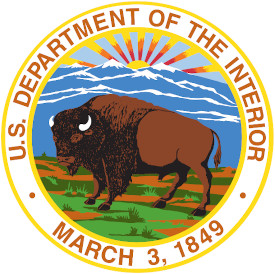
The official seal of the US Department of the Interior. This wide-ranging federal agency manages US public lands, natural resources, cultural heritage sites and oversees the Bureau of Indian Affairs. (Photo: DOI, Public Domain)
BASCOMB: As secretary of the interior Ms. Haaland has a broad portfolio from national parks to wildlife protection to the management of public lands, including permits and leases for coal mining and drilling for oil and gas. During her senate confirmation Deb Haaland faced fierce opposition from the fossil fuel industry that was already concerned about President Biden’s order pausing any new leases for oil and gas drilling on public lands. Speaking to senators she called for compromise to address the twin concerns of climate disruption and the need for fossil fuels.
HAALAND: There’s no question that fossil energy does and will continue to play a major role in America for years to come. I know how important oil and gas revenues are to critical services. But we must also recognize that the energy industry is innovating, and our climate challenge must be addressed. Together we can work to position our nation and all of its people for success in the future.
BASCOMB: Newly confirmed Secretary of the Interior, Deb Haaland.
Related links:
- NPR | “Deb Haaland Confirmed As 1st Native American Interior Secretary”
- The New Yorker | “Deb Haaland’s Historic Appointment Makes Her Uniquely Qualified to Confront the Fossil-Fuel Industry”
- Living on Earth Interview with Deb Haaland on December 7, 2018, shortly after she won her seat in Congress.
- More from LOE on Deb Haaland: "Fierce for our Planet"
[MUSIC: Peter Ostroushko et al, “The Land To Which We Belong” on Minnesota-A History Of the Land, by Peter Ostroushko, Red House Records]
One in Five Deaths from Fossil Fuels
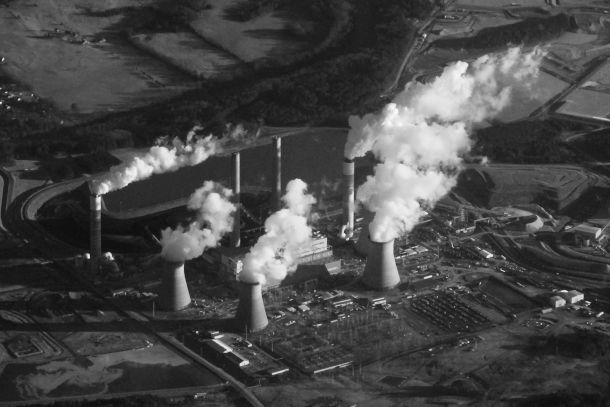
Plant Bowen just outside Euharlee, Georgia. It’s one of the biggest coal-fired plants in North America. The burning of coal is known to produce harmful ultrafine particulate matter. (Photo: formulanone, Wikimedia Commons, CC BY-SA 2.0)
CURWOOD: While the Covid-19 pandemic killed more than a half million Americans over the last year, a new report finds that every year some 300,000 or more Americans suffer premature deaths directly from burning fossil fuels. Fossil fuels like diesel and coal generate fine particles that can invade lungs and lead to a wide range of health problems including strokes, heart attacks, asthma as well as higher death rates from Covid. Worldwide, researchers found 8 million premature deaths are linked to fossil fuels. The study used methods that exclude other sources of fine particulates and was recently published in the journal Environmental Research. The work was conducted jointly by Harvard University and the Universities of Birmingham and Leicester in the UK. Joining us now is Pediatrician Aaron Bernstein, the interim director of the Center for Climate, Health and the Global Environment at Harvard, though he did not work directly on this study. Dr. Bernstein, welcome back to Living on Earth.
BERNSTEIN: Great to be with you, Steve.
CURWOOD: So this study measured the impact of particulate matter small ones, two and a half microns from only from fossil fuel combustion. Describe to me exactly what this study looked at.
BERNSTEIN: Yeah. So these authors wanted to understand not what air pollution outside in total does to health. They wanted, as you pointed out to understand what the proportion of that pollution that comes from burning fossil fuels does to human health.
CURWOOD: By the way, explain what is a premature death?
BERNSTEIN: So premature death is essentially someone dying before they rightly should. And at a population level, we know that in any given year, people die at certain ages. But when there's more pollution, we see people dying at ages earlier than those usual ages.
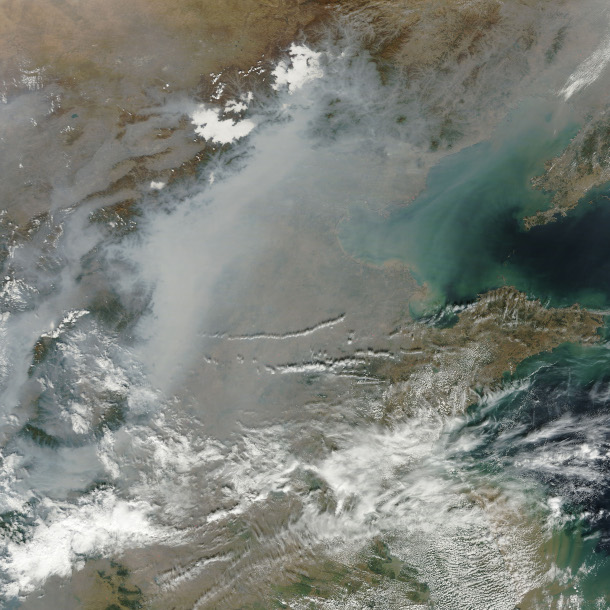
NASA satellite capturing a thick layer of haze over the North China Plain. Ground measurements that day revealed high concentrations of PM 2.5, or ultrafine particulate matter. (Photo: NASA Earth Observatory, Flickr, CC By 2.0)
CURWOOD: The numbers that they have here of 350,000 premature deaths every year in the United States. That is an astonishing number. What about around the rest of the world?
BERNSTEIN: Yeah, so globally, they estimate that somewhere around eight plus million people are dying every year from air pollution that comes from burning fossil fuels, which is roughly one in five deaths worldwide, which is just stunning.
CURWOOD: Now, who do these fossil fuel particulates affect the most? What kinds of populations or groups of people are most at risk?
BERNSTEIN: Yeah, it's, it's unfortunately, everybody who can least afford it. So research has shown quite clearly that anyone with a chronic medical condition, particularly people with heart disease, lung disease are at risk. People who are pregnant, or their pregnancies are at risk from this air pollution. There's lots of evidence that children with asthma will get sicker. And there's even some evidence that this air pollution may be causing asthma. We know this air pollution causes lung cancer. And there's a whole host of other nasty stuff that's coming into clear focus around the effects of air pollution on brain health, including on dementia, potentially contributing to diabetes. I should mention important to your question of who's affected most is that it turns out that pollution and poverty are really close bedfellows. And so regardless of where the air pollution happens, it's pretty much universally the case that people who are less well off are breathing more. In the United States, we have definitive evidence that people of color, particularly Black Americans, and Latinx Americans breathe more air pollution than the rest of us. And they are also least responsible for its production, meaning that they consume less goods that, you know, in their production result in the production of these air pollutants.
CURWOOD: Dr. Bernstein, what parts of the United States and the world are most at risk from these premature deaths from fossil fuel particulates?
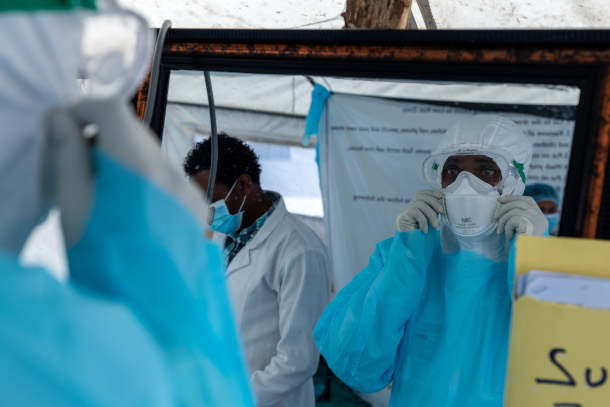
Healthcare workers securing their personal protective equipment. As of March 2021, worldwide deaths due to COVID-19 were around 2.63 million. The Harvard study revealed approximately 8.7 million people prematurely die annually from fossil fuel pollution. (Photo: UNICEF Ethiopia, Flickr, CC BY-NC-ND 2.0)
BERNSTEIN: Yeah. So this study, and others have shown that the places that are that are really suffering most from this air pollution are in Asia. Particularly in China and India and Southeast Asia, where the lion's share of the mortality from air outdoor air pollution is happening. Now, interestingly, Steve, you know, we've cleaned up the United States, dramatically, everyone's air quality has gotten better. The latest research shows, unfortunately, that the gains have not been equally shared. That in fact, white Americans have benefited most, whereas Black Americans and Latinx Americans have certainly benefited but not as much in the past several decades. But one of the consequences of us cleaning up our air is that we've exported the pollution. So there's been research now looking at how as manufacturing bases have moved, you know, from richer countries to low and middle income countries, that the pollution controls in those places are often less good. And the pollution that's being generated there is substantial. And in some research, for instance, China is certainly the place where the most deaths are occurring for goods that are serving people not in China, and the EU and in the US are the largest purchasers of those goods.
CURWOOD: How fair Dr. Bernstein is it to say nevermind, climate change, global warming from fossil fuels. Just look at the health effects of burning fossil fuels?
BERNSTEIN: Well, I think, you know, there's an interesting history here, Steve. So in the realm of climate change, the kind of health wins we get when we come off fossil fuels that this study shows are what are called the co-benefits, right? That's, that's the term that people use. These benefits aren't really the co-benefits. They are the health benefits of climate action. And I think it's critical that we start talking about them that way. Because to your point, you know, if 300,000 people roughly are dying every year in the United States from fossil fuel air pollution, and you know, 8 million people are dying globally, can you imagine what we would be doing if we treated this like we have COVID? I mean, the world is spending trillions upon trillions of dollars to deal with this pandemic. We're not spending a fraction of that to deal with the air pollution mortality from fossil fuel use.
CURWOOD: Yeah, Dr. Bernstein, when you make that point, we've seen a half a million people, more than half a million people in this country die over the last 12 to 13 months from COVID. But 300 to 350,000 deaths a year from fossil fuels quickly dwarfs that over well, over two years.
BERNSTEIN: You know, this is a global problem. And there's a real need to look at how we are valuing energy and goods when it comes to health. And if we in fact, included the health effects of our production system and the reliance on fossil fuels, we would be off fossil fuels tomorrow, because no one could afford using them.
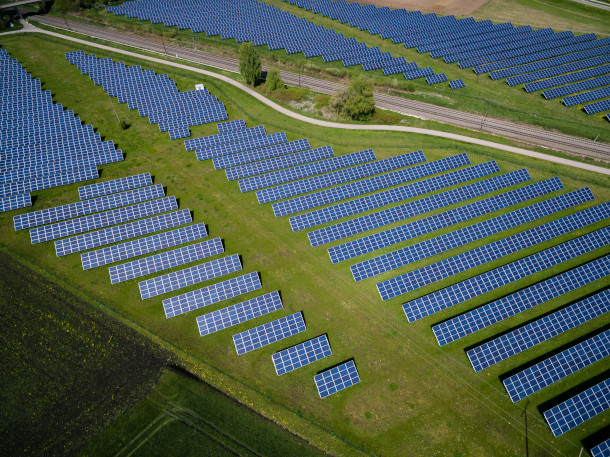
Solar farm in Offingen, Germany. Commitment to the transition to alternative energy sources is vital to reduce fossil fuel combustion. (Photo: Andreas Gücklhorn, Unsplash, Public Domain)
CURWOOD: So Dr. Bernstein if fossil fuels reflected their true cost, and obviously, it'll be very, very expensive. How do we work through this? What do you think it'll take to make the change?
BERNSTEIN: Yeah, so I think the first thing is, well, let's start accounting for it. You know, one of the things that's important to recognize is that in the United States, some of the rules that come out of the federal government do include health costs, but that is not the rule across federal agencies. But as you point out, you know, we can't even if we did that, we can't just, you know, flip a switch and change, change our economy. And so that's where I think policies that focus on what are the ways to essentially phase out our use of fossil fuels that will, you know, not essentially shoot ourselves in the foot. And also stimulate the needed growth in the alternatives because, of course, we can't just turn off fossil fuels without somewhere to jump to. And that requires real leadership, and really good policymakers who can work with people who understand economics, to implement the systems.
CURWOOD: Dr. Bernstein, what's the most important takeaway from this study? And what's next, do you think?
BERNSTEIN: The most important takeaway here is that we have so much more to gain than we previously understood by getting ourselves off fossil fuels. And that the health gains that we can achieve are going to benefit the folks who have been harmed the most, namely, people who are less well off, people of color, particularly Black Americans and Latinx Americans. And that not only will we improve their health and welfare, but the transition is going to be a huge engine for economic growth. We have so many more jobs to gain in moving to energy systems that do not rely upon fossil fuels, than by trying to do any kind of growth scheme within the realm of fossil fuels. So it is a huge opportunity for health. It's a huge opportunity for equity. It's a huge opportunity for the economy. I also think, Steve, it's critical to point out that there are millions of people in the United States and many more around the world who have spent their lives and in fact, for generations, in many cases, families have spent their lives dedicated to mining, transporting, processing, delivering fossil fuels. And we can't simply move on without addressing the reality that these families need help with this transition. We cannot lead a future with heavy reliance on fossil fuels. Might we have technologies to capture greenhouse gases out of the air that are cost effective? Sure. There's all kinds of technologies that might happen. But the science tells us we need to reduce our emissions massively in the next decade or we're going to be living in a world that people are increasingly not gonna like living in.
CURWOOD: Dr. Bernstein is a pediatrician and interim Chair of the Center for Climate, Health and the Global Environment at the Harvard T. Chan School of Public Health. Dr. Bernstein, thanks so much for taking the time with us today.
BERNSTEIN: Great to be with you, Steve. Thanks for having me.
Related links:
- Harvard T.H. Chan School of Public Health | “Fossil Fuel Air Pollution Responsible For 1 In 5 Deaths Worldwide”
- Click here to read a pre-proof version of a recent Environmental Research Journal paper on fossil fuel combustion and premature deaths
- Listen to an April 2020 LOE story on the harmful health effects of fine particulate matter
- More from the EPA on sources of particulate matter
[MUSIC: Force of Angels, “Dune” on Unitone World Sampler 1 – An Electronic World, by Justin Mackay, Unitone World]
CURWOOD: Author and NYTimes food writer Mark Bittman says , "Nothing is More Important than Food." And, "You can’t have a serious conversation about food without talking about human rights, climate change, and justice." For the next Living on Earth Book Club live online event, we chat with Mark Bittman about his latest book: ANIMAL, VEGETABLE, JUNK: A History of Food, from Sustainable to Suicidal." Please Join us on March 30 @ 5:30pm eastern daylight time. All you have to do is register at our website LOE.ORG and click "Events" at the top of the page.
[MUSIC: Force of Angels, “Dune” on Unitone World Sampler 1 – An Electronic World, by Justin Mackay, Unitone World]
BASCOMB: Coming up – Fracking for natural gas is transforming rural life in parts of Appalachia. That’s just ahead on Living on Earth.
ANNOUNCER: Support for Living on Earth comes from Sailors for the Sea and Oceana. Helping boaters race clean, sail green and protect the seas they love. More information at sailors for the sea dot org.
[CUTAWAY MUSIC: Newberger-Mazzy-Thompson, “Aunt Hagar’s Children” on The Men They Will Become, by W.C. Handy-Tim Brymn, Stomp Off Records]
Note on Emerging Science: Oldest DNA Ever Sequenced

The reconstructed skeleton of a Columbian Mammoth stands in the Page Museum in Los Angeles, California. Genetic evidence from the newly discovered Krestovka mammoth indicates that this species was a hybrid, descended from both Krestovka and wooly mammoths. (Photo: WolfmanSF, Wikimedia Commons, CC BY-SA 3.0)
BASCOMB: It’s Living on Earth, I’m Bobby Bascomb
CURWOOD: And I’m Steve Curwood.
Just ahead the serious health problems facing people when fracking facilities move in next door but first this note on emerging science from Grace Callahan.
[SCIENCE NOTE THEME]
CALLAHAN: Scientists have set a new record: they’ve sequenced the oldest DNA to date!
An international team of scientists led by researchers at the Centre for Paleogenetics in Sweden has pieced together the genome of a mammoth fossil, more than a million years old. They published their findings in the journal Nature. This shatters the previous record set by a horse bone some 700 thousand years old.
Every living thing contains DNA, the blueprint for life. But when something dies, that DNA starts breaking down into smaller and smaller pieces, eventually becoming illegible to scientists.
Extreme cold slows this breakdown, just like your freezer stops last week’s leftovers from rotting. So, in theory, if a sample of tissue was preserved perfectly in a state of constant cold, say, in permafrost, the genome could be preserved enough to be used for genetic sequencing.
That perfect sample came in the form of three mammoth teeth buried long ago in the frozen earth of present-day Russia. Each tooth came from a different mammoth, separated in time by hundreds of thousands of years. The researchers managed to piece together the DNA from these teeth, the oldest of which is between 1.2 and 1.6 million years old. It belongs to a new lineage of mammoths previously unknown to science. Scientists called their discovery the Krestovka mammoth, named after the village near which the tooth was discovered.
This new lineage is providing surprising insights into the evolution of later mammoth species. Columbian mammoths, named for Christopher Columbus, lived in North America until the end of the last ice age, about 11,500 years ago. This new genetic evidence suggests that Columbian mammoths were actually hybrids between this new Krestovka mammoth and Eurasian Steppe mammoths. This is the first evidence of hybrid speciation ever observed in ancient DNA.
The sequencing of DNA over a million years old is a thrilling development in the world of paleontology. Now that we’ve proved sequencing these ancient teeth is possible, paleogeneticists are setting their sights on future discoveries still waiting beneath the ice. DNA from other species could hold surprising clues to the history of life on our planet. Scientists hope that someday we may even find million-year-old hominid DNA and unravel the mysteries of our own ancient genetic history.
That’s this week’s note on emerging science. I’m Grace Callahan.
Related links:
- Nature | “Million-Year-Old Mammoth Genomes Shatter Record for Oldest Ancient DNA”
- Science News | “The Oldest Animal DNA Ever Recovered Reveals Mammoths’ Evolution”
[SCIENCE NOTE THEME]
Families Sickened by Fracking
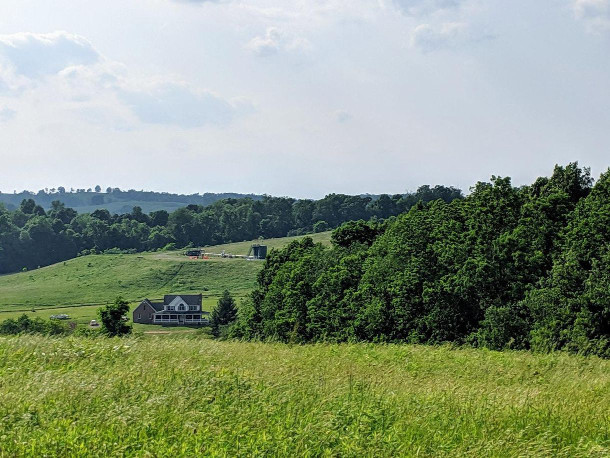
A bird's-eye view of Bryan and Ryan Latkanich's home and the fracking well pad up the hill behind it in the summer of 2019. (Credit: Kristina Marusic for Environmental Health News)
BASCOMB: When fracking facilities move in next door, they can completely upend rural life for many people. And there are serious health concerns associated with the chemicals used for fracking. Typically, a cocktail of generally toxic chemicals and water is injected into bedrock to create cracks through which oil and natural gas can be extracted. The chemicals each company uses are proprietary information not available to the communities where fracking occurs. But the water, air, and people can be sampled to get a sense of what chemicals are present. And in a 5-part series for Environmental Health News investigative reporter Kristina Marusic did just that. In addition to water and air testing, she took urine samples from 5 different families over the course of 9 weeks during the summer of 2019. Each of the families had at least 1 child in the home. Kristina sent the samples to the University of Missouri to analyze them and compared the chemical body burden for each of the families living near fracking with the national average. The results show very high levels for many of the 40 chemicals and chemical breakdown products they tested for including benzene, styrene, and toluene. In some of the children tested they found chemical levels more than 90 times higher than the national average, higher even than an adult smoker. Kristina started by telling me about a family that moved to the area in search of a peaceful place to raise their children.
MARUSIC: So the Bower-Bjornson family, the mom, Lois and the dad, Dave originally lived in Pittsburgh's north side, which is like a trendy neighborhood close to downtown here. And when they knew they were going to start a family, they wanted more space. So they started looking for houses a little further away from the city. And initially, they were looking in suburbs closer to Pittsburgh, but then they were out in Washington County and saw this beautiful home listed that had a barn on the property, and was kind of in the middle of the country. And they just fell in love with the idea of raising their kids somewhere so idyllic. They live in a neighborhood called Scenery Hill, which is an apt name for it, because it's these big, green, lush rolling hills with little patches of woods here and there, and family farms all over the place, and like a cute little Main Street with a cafe and a pie shop. So they moved there as a young family, before fracking had moved into the area. And within a few years of their being there, the fracking boom started, so fracking wells started to move in. And when that first started happening, they actually weren't overly concerned, they kind of thought, oh, this might be good for the economics of the region. Maybe it'll help the mom and pop shops. They actually sold, not their mineral rights, but they like leased part of their property to run a an oil and gas transmission line through for something like $12,000 in the early days of the boom to a fracking company. But pretty quickly, this kind of idyllic country lifestyle pretty drastically started to change. So all of a sudden, this small two lane road that's right in front of their house was inundated with heavy truck traffic. So there were dozens of huge trucks going by every day, the wells were close enough to their house that they could hear the drilling, they could smell the drilling, they could see flaring like these huge flames licking into the air at night. One of their four children, Gunnar, started getting nosebleeds pretty regularly. And they worried that it might be related to emissions from fracking.
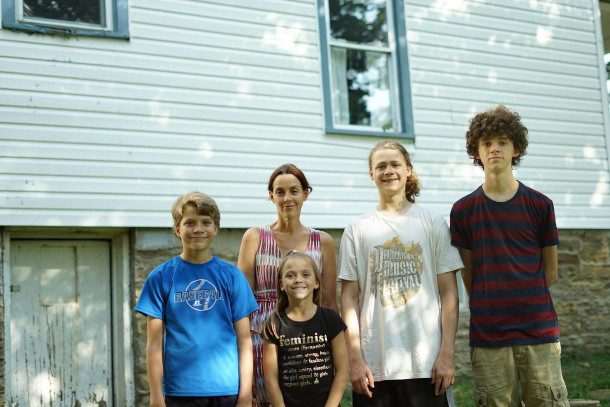
The Bower-Bjornson family (from left, Gunnar, Lois, Odessa, Nels and Kylan) at their home in Scenery Hill, PA. (Credit: Connor Mulvaney for Environmental Health News)
And Gunnar actually told me that once he got a pretty bad nosebleed in school, and he remembered asking his teacher not to tell his mom about it, because he knew that it made her really worried and stressed her out. So he didn't want her to know that he'd had a nosebleed at school. And then the gas line that takes gas from the main line into their house for you know, heating their home and for gas to their stove, ruptured. It ran under that little road, and so they felt almost certain that it ruptured, because of all this new heavy truck traffic. They had to pay to replace it, which was frustrating for them. So they just kind of became increasingly frustrated. They felt like this beautiful country property they had bought all of a sudden was in the middle of this heavy industry, which wasn't what they had signed up for. And so, you know, they were interested in getting tested because they were concerned about the potential for these exposures. They were concerned that, you know, it might have been causing their headaches and their rashes and their nosebleeds for several years. And then when they got the results of our study, they were pretty shocked to see in particular that the kids had some of these really high levels of exposures. And some of the highest levels of exposure we saw were in Gunnar, the child who had had the nosebleeds for years on and off.
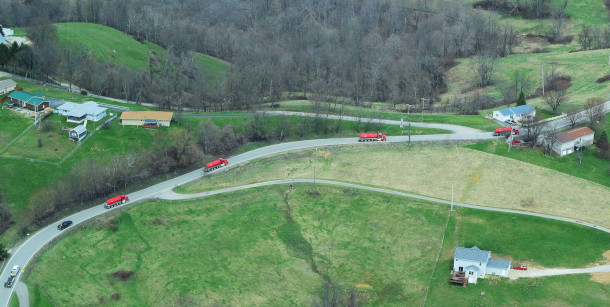
A line of fracking wastewater trucks in Moundsville, West Virginia (Credit: Ted Auch, FracTracker Alliance, 2019)
BASCOMB: And you write that they actually live now within five miles of about 25 active wells, many of which have several well pads each. I mean, that's a lot of industry in this formerly, you know, bucolic neighborhood.
MARUSIC: Yeah, it really has kind of changed the landscape there. When we got the test results back and I shared them with the family. She said, unless we move, there's no escaping this for us. We're completely surrounded by wells on all sides. And even when the kids go to school or to a friend's house, you know, unless they're leaving the state, they're still going to be near a fracking well, so they just feel kind of inundated and overwhelmed by the industry.
BASCOMB: So in addition to the physical health problems that you describe, you also say that there's some mental health consequences of living near fracking. Can you tell us more about that?
MARUSIC: Yeah. So there have been a number of studies that have found that people who live closer to a higher volume of fracking wells are more likely to experience things like depression, and anxiety, and trouble sleeping. And then there have been some other studies, some sociological studies that investigated why this is happening through things like surveys. And some of the reasons they found are, like I described with the Bower-Bjornson, a sense of loss that the place that they lived has been transformed from somewhere rural and quiet and peaceful into like a heavy industrial zone. Other reasons are worry and stress over the environmental impacts and the potential health impacts of fracking. And then a sense of distress in communities and alienation that happens. So some of these families we spoke to, one woman told me that she and her grandchildren had been screamed at at a community meeting by people who were making some money as a result of having leased their mineral rights. And were angry that someone whose kid was sick, who thought they were experiencing health problems as a result of fracking might get in the way of that. And so she reported that they felt really alienated and ostracized, and one of the teenagers who was involved in the study, she was 15. In the summer of 2019, we collected these samples, she asked to use a pseudonym, so we call her Lexy in the series, and she had been sick on and off for years after a fracking well went in about a half mile away from her elementary school.
And, you know, they went back and forth with a toxicologist and with the State Department of Health and they weren't getting answers, weren't getting answers. And eventually, their toxicologist found that Lexy had been exposed to benzene. But her toxicologist at this time suggested that the course of treatment was to remove her from the source of exposure, which was her school as hard as they knew. So it's a single grandmother raising Lexy and her brother and she was just like, what am I supposed to do? You know, do I pull them out of school, do we move? And her toxicologist at the time said she likely had a particular sensitivity to benzene. And I should back up and say at the beginning of all this, when she started getting sick, and they went to just their primary care doctor, they had tried everything. They had, you know, switch their detergent, they had ripped up all the carpeting in their house, they tried food elimination diets, they had tried thing after thing after thing, and nothing was helping. And then it eventually came out that she had been exposed to benzene and that she had a particular sensitivity to benzene exposure. And she had a really hard time at school, she wore an air monitor that would make noise if the levels of VOCs got above a certain limit. But then that became embarrassing for her. She was in middle school at the time, and it would like make this loud noise. And then all of her classmates would know. And then her teachers would be frustrated because that was disruptive. And they would ask her to leave. She got like violently ill at school, and vomited in front of everyone. So she felt like she just became that sick girl.
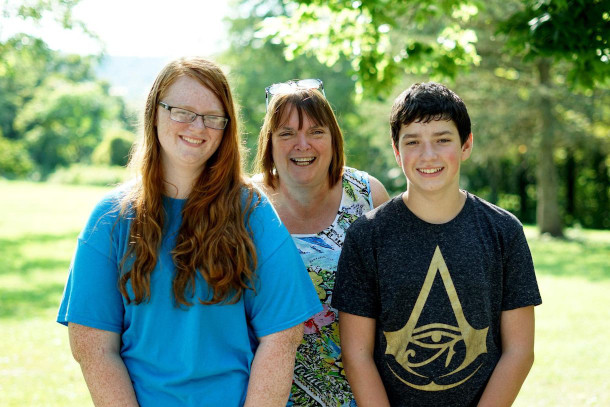
Lexy, Jane Worthington and Damien. (Credit: Connor Mulvaney for Environmental Health News)
And then she had fellow classmates saying things to her like, are you just making this all up? Are you lying? My mom says you're lying about this to get attention or the rest of us would all be sick if this was really happening. So, how come you're the only one sick? And she told me that she had experiences where she went to a friend's house on a couple occasions and the friend's parents wouldn't stop grilling her about, you know, tell the truth. Are you making this up? Are you really sick? And they eventually moved because they felt so ostracized in this community. And they had moved when we did our testing and unfortunately, we still found evidence that Lexy was being exposed to benzene. So they were left feeling really frustrated. And Lexy in particular reported a lot of mental health impacts as a result of this, you know, she developed anxiety, she got depressed because she felt like there was nothing that they could do about this. And yeah, she's someone who has just really struggled with the way that living around this industry has impacted her life as a young person.
BASCOMB: Well, you write about another family in your series. This was a father and son, where the father was happy to allow fracking on his property some time back, but then kind of regretted that decision. Can you tell us more about that story?
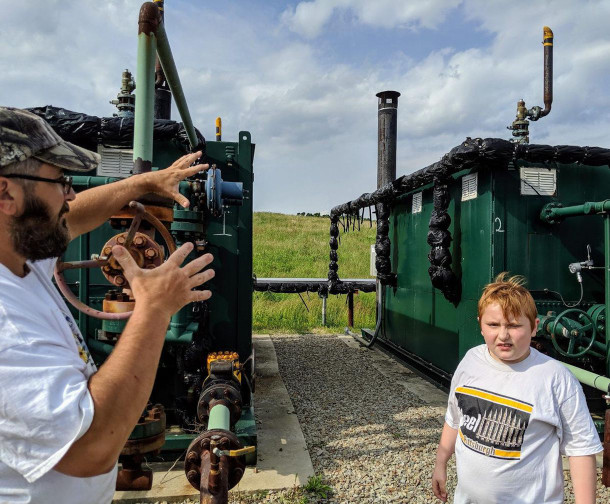
Bryan and Ryan Latkanich in front of the fracking infrastructure that was formerly active on their property in the summer of 2019. (Credit: Kristina Marusic for Environmental Health News)
MARUSIC: Yeah, so that is Brian Latkanich, and he's a single dad. His son, Ryan lives at home with him. And they invited a fracking company to drill a well on their property kind of early on in the boom, around 2011. In Pennsylvania, and in a lot of other states, there's something called a setback rule, which determines how far away a fracking well has to be from like a home or a school. In Pennsylvania, that distance currently is 500 feet. But if a property owner waives their rights, then it can be closer and that was something that Brian Latkanich opted to do. So the well pad was drilled about 400 feet from his house, and he was really gung ho about this. At the beginning, he described himself as a cheerleader for the industry because he was so excited about the royalties he was promised and he thought that they were going to become millionaires and move the house and sell somewhere else and get something bigger. But then, pretty quickly after the well went in, Brian and Ryan both started experiencing a whole slew of health problems, things like nosebleeds, rashes, trouble breathing, eye irritation. They've both had some pretty severe stomach problems. And at one point, Ryan, he was nine years old at the time that we did our testing. And he had a level of hippuric acid, which is a biomarker for toluene, in his urine that was more than 91 times as high as the US median, and almost five times as high as the US 95th percentile. At the time that wells went in, he was really little. And a couple years after it had been drilled, he came out of the bathtub with sores all over his body. And that was the beginning of Brian's experience, trying to work with state agencies here in Pennsylvania to get help for this. So he called the State Department of Environmental Protection, he called the State Department of Health, they had their water tested, and he has a private well. And after numerous tests, the State Department of Environmental Protection, told him essentially your water is to contaminate to drink, don't drink it, but that they didn't believe the fracking company was to blame or that they couldn't prove definitively that it had been to blame. So that meant that the fracking company wasn't required to provide him with water. So he had to start buying bottled water for him and Ryan, but they still had to bathe in this water and obviously, that was a concern. So they contacted the State Department of Health about that. And the State Department of Health advised them that if they were concerned that they should shower elsewhere. They recommended going to the nearest YMCA to shower and the nearest YMCA is about a 30 minute drive for him. So, right it just didn't seem feasible, what are they going to go every day to shower outside of their home indefinitely? The royalties were also much, much smaller than he had says he had been led to believe. So he was expecting to get huge amounts of money from this. And instead, it turned out to be not a whole lot. So, he is disabled and on a fixed income. So he feels that he can't afford to move, he feels stuck there.
BASCOMB: So just to be clear, he was saying his water was fine, there was no problem. And then fracking comes in 400 feet from his house, suddenly the water is too toxic for them to consume or bathe then, but the DEP finds that the fracking company is not responsible.
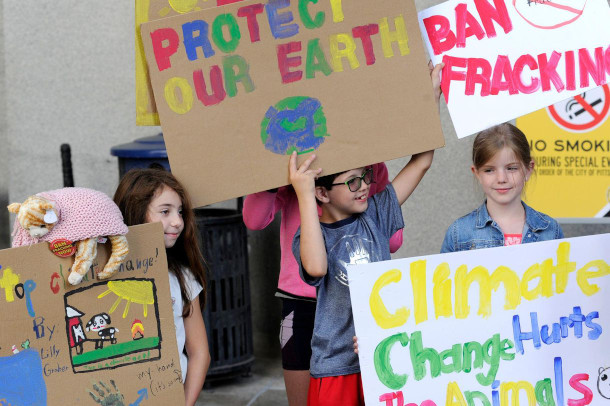
Children from two families involved in EHN's study participate in a 2019 youth climate change protest in downtown Pittsburgh. (Credit: Connor Mulvaney, Environmental Health News)
MARUSIC: Yeah, and that happens a lot. There was a big report by a newspaper, Public Herald, a couple of years ago that looked at all of the water complaints related to fracking in the state, and found that more than 90% of the time, when the Pennsylvania Department of Environmental Protection had investigated, they had ruled exactly like they did in Brian's case, which is that a fracking company couldn't be held liable for water contamination. So there are a lot of environmental advocates who are saying something looks wrong here. How is it possible that all of these thousands and thousands of people have had their water contaminated? And you know, there are fracking wells going in nearby? And so people obviously think that maybe that has something to do with it. And then you know, the DEP is finding that it doesn't. And there are a lot of reasons for that. But a big one is that this industry is relatively unregulated at the federal level. And so that leaves regulation up to the states, and the states that have to oversee and regulate these industries often are underfunded in the departments that do this kind of work. So you know, it might not necessarily be any kind of nefarious collusion with oil and gas, but it might just be a lack of resources. And that's something that I heard from a lot of these families that, you know, they just felt that they weren't getting answers, and they weren't getting help.
BASCOMB: Well, you know, of course, knowledge is power. So these families, they have this information now about the chemical body burden that they're carrying around. But what can they do with that? What are they planning to do now that they know how toxic their community and their homes are?
MARUSIC: I hope that having these test results will empower them to be able to better advocate for their health, for the health of their kids, and for the safety of their communities. And I have seen that start to happen since the series was published. So Lois Bower-Bjornson , who is the mom in the Bower-Bjornson family we talked about, has been CC-ing me on emails to every Pennsylvania state lawmaker she can find contact information for and saying, my family is one of the families that was studied here. She was very upset to learn about these exposures. But she also said, you know, I feel like for years people have been saying, maybe she's crazy. Maybe she's making it up. Maybe she's just being dramatic. And now I have proof. This is happening to me and my family. We have these high level of exposures. You know, we did these scientific tests that show that we have these level of exposures. So who is going to help us? What are you going to do to protect us? And so, I've been glad to see that she feels empowered by having this information to advocate for her family. And you know, I think the first next step is for someone to do similar research on a much larger scale. But I also think that what I found in this investigation should serve as a wake up call about the need to better understand whether fracking chemicals are getting into the air or water or bodies of people who are living near wells. And I also think, you know, it's not partisan to say that we're opposed to children being poisoned. And so I think this testing that we did clearly shows the need for more careful oversight of this industry, and for better systems in place to help serve these families who just feel like they're being put in harm's way and no one is there to help them or look out for them.
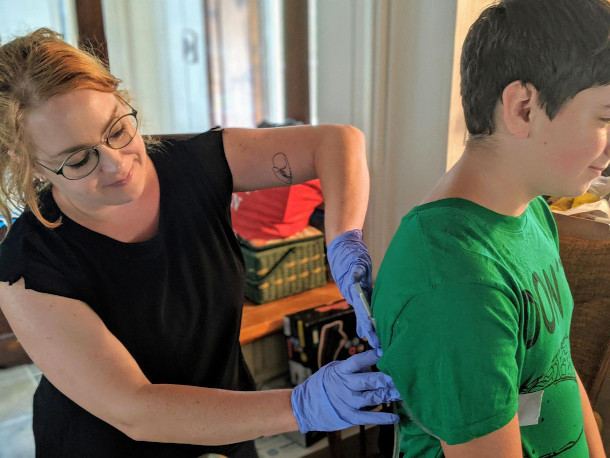
EHN reporter Kristina Marusic (left) sets up an air monitor for Damien Schaffer (right). (Credit: Mason Secreti)
BASCOMB: Kristina Marusic is an investigative reporter with Environmental Health News. Kristina, thank you so much for sharing this time with me and this really compelling investigation you've done.
MARUSIC: Yeah, thank you so much for talking with me. I really appreciate it.
Related links:
- Click here for the ‘Fractured’ landing page
- Environmental Health News | “Fractured: Harmful Chemicals and Unknowns Haunt Pennsylvanians Surrounded by Fracking”
- Environmental Health News | “Fractured: The Stress of Being Surrounded”
- Environmental Health News | “Fractured: Distrustful of Frackers, Abandoned by Regulators”
- Environmental Health News | “Fractured: Buffered From Fracking but Still Battling Pollution”
- Learn more about how Environmental Health News collected and analyzed their data
- Click here for the ‘Fractured’ FAQ page
[MUSIC: Jerry Rockwell, Introduction to “Scarborough Fair,” on “The Mountain Dulcimer: A Musical Possibility Box, TEDxStroudsRun]
CURWOOD: Coming up – One man’s quest to buy a climate-friendly refrigerator.
Keep listening to Living on Earth.
ANNOUNCER: Funding for Living on Earth comes from you, our listeners, and United Technologies, combining passion for science with engineering to create solutions designed for sustainability in aerospace, building industries, and food refrigeration.
[CUTAWAY MUSIC: Trace Bundy, “Canon in D,” studio session, by Johann Pachelbel]
Beyond the Headlines

Up to one billion migrating birds collide with US buildings each year and the Philly Lights Out Program could help prevent 80% of bird collisions in the city. (Photo: R’lyeg Imaging, Flickr, CC BY-NC-ND 2.0)
BASCOMB: It’s Living on Earth, I’m Bobby Bascomb
CURWOOD: And I’m Steve Curwood
CURWOOD: It's Living on Earth, I'm Steve Curwood and it's time now for us to turn to Peter Dykstra for a look beyond the headlines. Peter is an editor with environmental health news as ehn.org and daily climate.org. On the line now from Atlanta. Hi there, Peter. How are you today? And what do you have for us?
DYKSTRA: I've got some good news from the City of Brotherly Love Philadelphia. They've announced a Lights Out Initiative. Philly will turn off and dim its skyscraper lights during the spring and fall migratory seasons to make it easier for birds. It's estimated that anywhere from about a third of a billion birds to a full billion birds die from building collisions each year.

The ovenbird (pictured above) is one of the many birds that are at risk of extinction from climate change. The ovenbird is one of the 300 bird species that migrates on a flyway that passes through Philadelphia and could benefit from the Philly Lights Out Program. (Photo: Fyn Kynd, Flickr, CC By N.C. N.D. 2.0)
CURWOOD: Yeah, but Philly's not the first city to do this, right Peter?
DYKSTRA: Yeah, that's what's cool about this program established by the National Audubon Society in 1999. The first Lights Out city was Chicago, Philly would be the 34th for the Lights Out initiative.
CURWOOD: And just to remember, birds like to migrate at night and rest during the day. So it's pretty easy for them to get confused by bright lights, they ordinarily use the stars to migrate. Hey, what else do you have for us?
DYKSTRA: Well, there's a big event in the insect world coming. It happens every 17 years, covering an area from Atlanta, the edge of it up to the east coast and out to Chicago. And that 17 year phenomenon is the emergence of Brood X, X as in the Roman number 10. That's when the loudest insect cacophony happens. It's when the cicadas called Brood X emerge from the ground and chirp and make noise for about a month.
CURWOOD: Here's a bit of tape from 17 years ago.
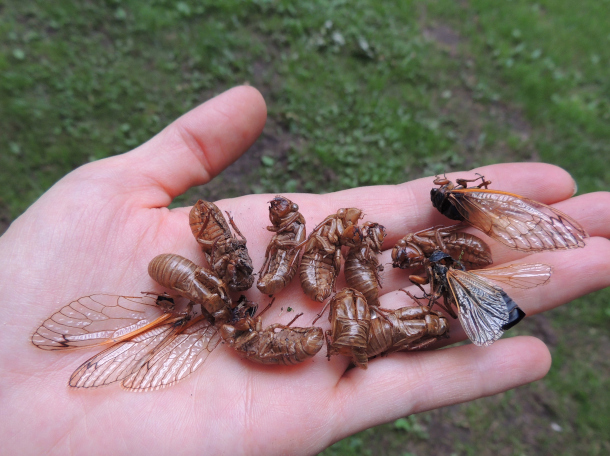
After spending seventeen years underground Brood X cicadas will swarm the Midwest and Eastern United States from around mid-May to late June. (Photo: Anita Gould, Flickr, CC BY 2.0)
[Cicadas Chirping]
CURWOOD: Those are loud!
DYKSTRA: They are and they're all over the place. The ones that have died, they'll be cicada bodies littering the ground. Let me tell you a personal story from the last time it happened back in 2004. I was working at CNN and we sent a couple of crews and reporters out to hear and see the cicadas doing their spring break because this is also mating season. They mate, they lay eggs at the end of it. The eggs go to sleep for 17 years, and they come out again. But back in 2004 we had reporters getting hit upside the head by cicadas and in one memorable TV moment there was a reporter doing a live wrap up for her cicadas story and a cicada on national television flew straight into her mouth.
CURWOOD: So I imagined that she chewed and swallowed it the way many traditional cultures around the world do when the cicadas emerge.
DYKSTRA: My memory is fuzzy on this one. I don't remember. I don't think she swallowed it. But there's so many cicadas littering the ground. You could scrape them up and make a soup. I wouldn't recommend it because it's not delicious, but it's low calorie, low carb sugar free gluten free.
CURWOOD: [LAUGHS] Hey, let's take a look back into history now Peter, tell me what you see.
DYKSTRA: March 22nd 1989 kind of an unsung environmental tribute happened when the Basel convention was ratified,* outlawing some but not all transshipments of toxic waste, and other potentially poisonous trash. The issues covered by Basel have grown of course, with the huge upswing in electronic waste being shipped to China, Malaysia and other countries for storage and Basel is also looked to take on other issues most recently, the plague and the scourge of plastic waste around the world.
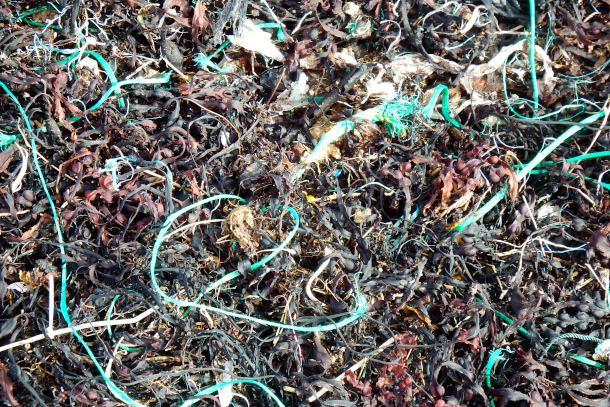
The Basel Convention was signed on March 22, 1989 and it’s meant to minimize the accumulation of toxic waste and its transfer to less developed countries. (Photo: Willowherb, Flickr, CC BY-NC 2.0)
CURWOOD: Such a big one. Thanks, Peter. Peter Dykstra is an editor with Environmental Health News, that's ehn.org and dailyclimate.org. We'll talk to you again real soon.
DYKSTRA: All right, Steve, thanks a lot. Talk to you soon.
CURWOOD: And there's more on these stories on the living on earth website. That's LOE DOT ORG.
*Correction: The Basel Convention was signed on March 22, 1989 and has been ratified by 188 countries.
Related links:
- Learn More about the National Audubon's Lights Out Program
- The Washington Post | “Brood X Cicadas are About to Put On One of the Wildest Shows in Nature. And D.C. is the Main Stage”
- Ted Ed | “Cicadas: the Dormant Army Beneath Your Feet”
- Learn More About the Basel Convention
[MUSIC: The BB King Blues Band, “Low Down” on The Soul of the King, by B.B. King, Ruf Records]
BASCOMB: Your comments on our program are always welcome. Call our listener line anytime at 617-287-4121. That's 617-287-4121. Our e-mail address is comments at loe dot org. - comments at loe dot org. And visit our web page at loe dot org. That's loe dot org.
[MUSIC: The BB King Blues Band, “Low Down” on The Soul of the King, by B.B. King, Ruf Records]
Carbon Bomb Fridges

Your refrigerator could be hiding a “climate bomb” of HFC gases. (Photo: nrd on Unsplash)
CURWOOD: The climate emergency is so vast a problem that individual actions alone can’t solve it. But collectively personal choices do add up and can make a difference. So, when Inside Climate reporter Phil McKenna needed a new fridge, he wanted to steer clear of any appliance that would use super-potent greenhouse gases to cool his groceries. And as someone who often writes about the kinds of “super-pollutant” chemicals that might be lurking in a shiny new fridge, he knew just what to look for. Or so he thought. The fridge Phil bought ended up being a “climate bomb”. One that secretly contained a greenhouse gas literally thousands of times more potent than carbon dioxide. He wrote about his saga for Inside Climate News and joins me now from Cambridge, Massachusetts. Phil McKenna, welcome back to Living on Earth!
MCKENNA: Steve, thanks for having me.
CURWOOD: So, how did this happen? How did you, a climate reporter, end up buying a refrigerator with what you call a super-polluting refrigerant?
MCKENNA: As I set out to buy a fridge, this was something that was really important to me. I knew that there were two types of refrigerators on the market, ones that were climate-friendly, and ones that, as I write, were climate bombs. I wanted to avoid HFCs, or hydrofluorocarbons. These are chemical refrigerants that are thousands of times worse for climate change than carbon dioxide. And I wanted to get isobutane, which is another refrigerant that is only a few times worse than carbon dioxide, essentially the same as carbon dioxide, and in the small amounts used in refrigerators, essentially negligible as a greenhouse gas. And I knew where to go, I thought I had this all locked up. I had recently seen Future Proof, a website that does reviews of consumer goods with a focus on sustainability, had just profiled the most climate-friendly refrigerators of 2020. So I went there and found one that looked great, and I ordered it.
CURWOOD: So, you order this refrigerator that has the isobutane, not much of a climate footprint. And what happens when the fridge arrives?
MCKENNA: Well, I should step back to a few days before the fridge arrived, I got nervous and thought, you know, what if it really doesn't have isobutane? So I contacted the company, I asked a question, was this HFC-free, does it use isobutane? And they said "yes, as of January 2020, all of our refrigerators now use isobutane for their refrigerant."
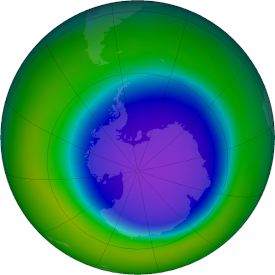
The blue and purple ozone hole over Antarctica in October 2020. HFCs were introduced in the 1990s to replace CFCs, which depleted the ozone layer that shields Earth from harmful solar radiation. But HFCs are now warming the globe. (Image: NASA Goddard Space Flight Center)
CURWOOD: So you're feeling happy now! You call, they tell you that you're getting the thing that you want, everything should be good to go. And yet, I'm talking to you, why?
MCKENNA: When the fridge arrives, I open it up and look inside. And sure enough, it uses HFCs. It uses chemical HFC-134a, which is 3,710 times worse for the climate than carbon dioxide over the near term. I write it was essentially as if they'd delivered not only a refrigerator, but also a barrel of oil and a slow burning fuse. Eventually, that will go into the atmosphere.
CURWOOD: Whoa. All right, so, you're a reporter. So aside from being unhappy, you obviously investigated. What happened?.
MCKENNA: I was livid! At first, I was a consumer more than a reporter. And I called up and spoke to their customer service and explained what happened. They were surprised, because as far as they knew, the switch had been made. They offered, though, they said they couldn't pay for it to be sent back to Home Depot, where I bought it. But they could send a service technician to come take a look at the refrigerator.
CURWOOD: Wait a second. [LAUGHS] Oh my goodness. This is like my worst experience with customer service lines. They pay no attention to what you're calling about. And they just keep reading on the script.
MCKENNA: To me the answer was, was clear as day. I knew what the problem was, they sold me one thing and delivered another. And I said, "you know, I don't need someone to come out and look at this, I need you to take some corporate responsibility."

HFC-cooled refrigerators are now being phased out in the U.S. (Photo: Ello products, Unsplash)
CURWOOD: And for the record, Phil, what you wanted isn't exactly rare or esoteric. As I understand it, there are plenty of refrigerators that use either propane or isobutane.
MCKENNA: In the US, it's only recently that climate-friendly refrigerators are available, within the last few years. GE Appliances, where I bought my refrigerator from, I later spoke to their press office and they apologized profusely and said, you know, more than half of the models that we sell now are HFC-free. And within the next couple of years, all of them will be. But you're right, in other countries, starting in Germany in 1993, the first HFC-free refrigerators were sold and marketed as being climate-friendly under the name "Green Freeze." And now worldwide, more than 1 billion HFC-free refrigerators have been sold and used worldwide.
CURWOOD: By the way, what did the company now tell you about what they were going to do with the machine that was sitting in your house, all shiny and new and not the thing you want?
MCKENNA: Once I spoke to the press officer, she was incredibly apologetic, and in fairness to the company, I don't believe they misrepresented things intentionally to me. And you know, she offered to have it returned. At that point, though, I'd already spoken to Home Depot, and they had already agreed to pick up the refrigerator for me.
CURWOOD: And give you back your money, of course.
MCKENNA: They would give me back my money and they did that by calling up GE Appliances themselves. And they said yep, no problem, GE will take it back. And I said, "Oh- you know, did you, did you explain to them all of the HFC-free, HFCs, all of that?" Because my thought was, the representative I was talking to must, her eyes must have just glazed over when I started going into all of this. And she said, "No, I didn't. But you know what I told them, was that your refrigerator was not cooling properly. It was not cooling the way it should."
CURWOOD: So one would think that as a reporter, then, you said, "I bet I'm not the only person this has happened to." What did you find when you started digging deeper on this, this matter?
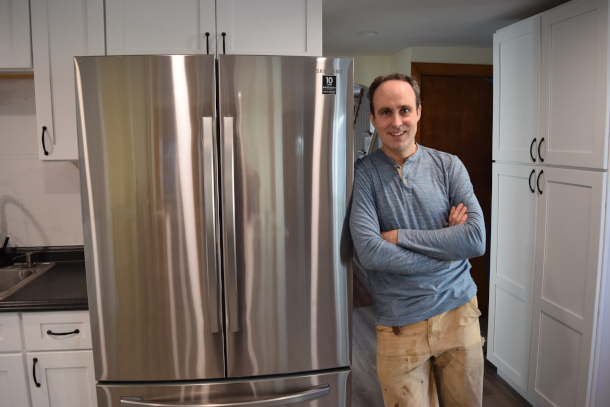
Phil Mckenna poses with his new, HFC-free Samsung refrigerator. (Photo: Rachel Parrish)
MCKENNA: Yeah, I wasn't the only one. I spoke to the Environmental Investigation Agency, a nonprofit environmental group based in Washington. And EIA, one of their main focuses and missions is fighting climate super pollutants. So this is really in their wheelhouse. And they've lobbied and done a lot of work to make it so that we now have the HFC-free options that are now available. And yet, they had the same issue a couple of years ago, when their office refrigerator broke. When they tried to buy an HFC-free refrigerator, they had an incredibly difficult time. It left both of us thinking that, you know, this really should not be the case.
CURWOOD: So my next question then, is why? I mean, you'd think that a climate-friendly appliance would be a great selling point. So why is it so hard for consumers to find out what they're getting? And for these companies to supply such devices to people like you and this agency?
MCKENNA: That's one of the most frustrating things for me. I posed this to GE Appliances, and they said, you know, at the end of the day, there's just not that much consumer awareness about this. But I don't think that completely answers it. And I think a lot of that consumer awareness could be driven by, and should be driven by, the manufacturers who are making this alternative. One thing that I do know, in other reporting I've done on refrigerants, is that a lot of the refrigerant manufacturers are based in the US. And this is a multi-billion dollar industry making HFCs and other patented chemical refrigerants. The alternative, climate-friendly, isobutane, propane, these are less expensive, more efficient refrigerants that can't be patented. And this industry would have everything to lose if, if these alternatives were out there and in use. So every time that EIA and others have pushed to get these alternatives on the market, there's been intense pushback from industry. And my guess is that that's part of what's driving this.
CURWOOD: Phil, what what advice do you have for someone listening right now, whose fridge just went on the fritz, or maybe they're moving dwellings and they're going to get a new one, what do they have to do to avoid buying a super polluting appliance?
MCKENNA: So one of the upshots of this story that I wrote is that GE Appliances has told me that they will now release their list. They have 180 or so different models of refrigerators and freezers that are HFC-free. They have only kept it internally until now, but tell me that they will be releasing it on their website. The other is that EIA, the Environmental Investigation Agency, has a website, HFC-free refrigerators buyer guide where you can go and look at potential models that you're interested in, so that you do indeed get the climate-friendly refrigerator that you want.
CURWOOD: By the way, Phil, so the refrigerator you refused is still out there. And my guess is that most of us listening to this program in the United States have a refrigerator that has this climate bomb inside it. What's to be done when those refrigerators are to be retired? How can those gases be kept out of the atmosphere?
MCKENNA: The EPA has a voluntary program for capturing and disposing of HFC refrigerants that are in refrigerators, and about 600,000 refrigerators in the US each year go through this program and the gas is properly disposed of. And that's really encouraging. Yet, about 9 million refrigerators are thrown out each year. So it's only really a small fraction that are properly disposed of when you have it hauled away.
CURWOOD: Well thanks, Phil! Phil McKenna is a reporter for Inside Climate News.
MCKENNA: Thank you.
Related links:
- Read Phil McKenna’s story for Inside Climate News | “I Tried to Buy a Climate-Friendly Refrigerator. What I Got Was a Carbon Bomb.”
- EIA’s HFC-free Refrigerator Buyer Guide
- Learn about Responsible Appliance Disposal from EPA
- Find a fridge that's HFC-free and Energy Star certified
[MUSIC: Christian McBride Trio, “Down By the Riverside” traditional African-American, live studio session at KNKX]
CURWOOD: Living on Earth is produced by the World Media Foundation. Our crew includes Naomi Arenberg, Paloma Beltran, Grace Callahan, Jenni Doering, Jay Feinstein, Paige Greenfield, Mark Seth Lender, Don Lyman, Aynsley O’Neill, Jake Rego, Natalie Seo, and Jolanda Omari.
BASCOMB: Tom Tiger engineered our show. Alison Lirish Dean composed our themes. You can hear us anytime at L-O-E dot org, Apple Podcasts and Google Podcasts, and like us, please, on our Facebook page - Living on Earth. We tweet from @livingonearth. And find us on Instagram at livingonearthradio. I’m Bobby Bascomb
CURWOOD: And I’m Steve Curwood. Thanks for listening!
ANNOUNCER: Funding for Living on Earth comes from you, our listeners, and from the University of Massachusetts, Boston, in association with its School for the Environment, developing the next generation of environmental leaders. And from the Grantham Foundation for the protection of the environment, supporting strategic communications and collaboration in solving the world’s most pressing environmental problems.
ANNOUNCER 2: PRX.
Living on Earth wants to hear from you!
Living on Earth
62 Calef Highway, Suite 212
Lee, NH 03861
Telephone: 617-287-4121
E-mail: comments@loe.org
Newsletter [Click here]
Donate to Living on Earth!
Living on Earth is an independent media program and relies entirely on contributions from listeners and institutions supporting public service. Please donate now to preserve an independent environmental voice.
NewsletterLiving on Earth offers a weekly delivery of the show's rundown to your mailbox. Sign up for our newsletter today!
 Sailors For The Sea: Be the change you want to sea.
Sailors For The Sea: Be the change you want to sea.
 The Grantham Foundation for the Protection of the Environment: Committed to protecting and improving the health of the global environment.
The Grantham Foundation for the Protection of the Environment: Committed to protecting and improving the health of the global environment.
 Contribute to Living on Earth and receive, as our gift to you, an archival print of one of Mark Seth Lender's extraordinary wildlife photographs. Follow the link to see Mark's current collection of photographs.
Contribute to Living on Earth and receive, as our gift to you, an archival print of one of Mark Seth Lender's extraordinary wildlife photographs. Follow the link to see Mark's current collection of photographs.
 Buy a signed copy of Mark Seth Lender's book Smeagull the Seagull & support Living on Earth
Buy a signed copy of Mark Seth Lender's book Smeagull the Seagull & support Living on Earth

